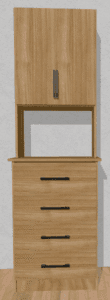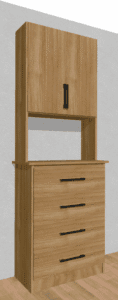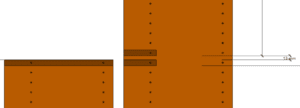Understanding Stacked Cabinets in ClosetPro
ClosetPro allows designers to build taller configurations by stacking cabinets or sections. However, because ClosetPro follows the 32 mm system, stacked cabinet heights may not match the height of a single full-height gable placed beside them.
This article explains why this happens, how to calculate the correct height for stacked units, and what to watch for when using special-height gables.
Why 32 mm System Heights Don’t Always Add Up
ClosetPro uses predefined gable heights based on the 32 mm drilling system.
This means:
- Standard gables follow fixed 32 mm increments.
- Shelf pin holes start 9.5 mm from the top and repeat every 32 mm.
- Because these heights are fixed, stacked components often do not equal the height of a single continuous gable.
When stacking cabinets, ClosetPro will always force the upper section to use a standard 32 mm height unless you manually adjust it later in Sherwood Shelving’s OLO ordering system.
Full-Height Tower
- Gable height: 2195 mm (86.417″)
Base Cabinet
- Height: 1011 mm (42.232″)
Countertop
- Thickness: 19.05 mm (¾”)
Goal
Stack a cabinet on top of the base cabinet and have the total height equal 2195 mm.
Step 1 — Calculate the Required Upper Cabinet Height
To find the height of the upper cabinet gables, subtract anything below it from the overall target height:
- Starting height (full tower): 2195 mm
- Minus base cabinet: 1011 mm
- Minus countertop: 19.05 mm
Required height = 2195 − 1011 − 19.05 = 1164.95 mm
Rounded to the nearest millimeter: 1165 mm
Required upper cabinet gable height: 1165 mm
Step 2 — Why Standard 32 mm Gables Won’t Work
The closest standard 32 mm gable heights are:
- 1139 mm (too short)
- 1171 mm (too tall)
Neither matches the required 1165 mm. The upper cabinet must use a special (non–32 mm) gable height, which you will adjust after importing the design into Sherwood Shelving’s OLO system.
Step 3 — How Hole Placement Changes on a Special Gable
On standard 32 mm gables:
- The top hole is 9.5 mm from the top.
- Holes are spaced at 32 mm increments.
- The bottom hole is 9.5 mm from the bottom (only for standard heights).
On a special-height gable:
- The hole pattern still starts 9.5 mm from the top.
- The bottom hole will not end 9.5 mm from the bottom.
- The drilling pattern stops wherever the last 32 mm increment falls.
This affects how fixed shelves align within the cabinet.
Step 4 — Why Avoid a Bottom Fixed Shelf in the Upper Cabinet
Because the special-height gable does not end on a standard drilling cycle, a bottom fixed shelf in the upper section will not align with the top fixed shelf of the base cabinet below. In this example, the misalignment is about 13 mm, creating a visible gap between shelves.
Recommendation: Do not include a bottom fixed shelf in the upper stacked cabinet. Leave the bottom of the upper cabinet open to avoid alignment issues. For the same reason a standard-sized door will not fit in the upper cabinet. Moving the bottom fixed shelf to a higher position, leaving an open space, is the recommended process especially if you want doors.
Example 2: The Visual Diagram (No Countertop – see image above)
The visual diagram (above) used to explain this concept removes the countertop to simplify the comparison of gable heights.
The diagram shows:
- Full-height gable: 2195 mm
- Base cabinet gable: 1011 mm
- Two upper gables (standard 32 mm sizes): 1171 mm and 1203 mm
Key points:
- 1171 mm is close but about 13 mm too short to match the full-height tower when stacked above the base cabinet.
- 1203 mm is too tall and will exceed the tower height.
This demonstrates how 32 mm increments can create height mismatches when stacking cabinets.
Why the Countertop Example and the Diagram Look Different
Both examples teach the same principle but under slightly different conditions:
Countertop Example
- Includes a ¾” (19.05 mm) countertop.
- Shows how to calculate the required special height of the upper cabinet.
- Represents a common real-world installation.
Diagram Example
- Removes the countertop for simplicity.
- Focuses on comparing standard 32 mm gable heights.
- Makes the height mismatch easier to see visually.
Even though the setups are slightly different, both examples illustrate the same core concept: stacked 32 mm system gables rarely match the height of a full-length gable without using a special-height top section.
Quick Reference: Stacking Cabinets in ClosetPro
- Expect height mismatches when using only standard 32 mm gables.
- Use this formula to calculate the upper cabinet height:
Overall Height − Base Cabinet Height − Countertop Thickness (if used).
- Set special-height gables in Sherwood Shelving’s OLO system after importing the order.
- Remember that on special-height gables, the bottom hole will not end 9.5 mm from the bottom.
- Avoid bottom fixed shelves in upper stacked cabinets to prevent visible gaps between shelves.
Final Notes
Understanding how the 32 mm system affects stacked cabinet heights will help ensure accurate designs and avoid alignment issues when stacking sections or units in ClosetPro.





